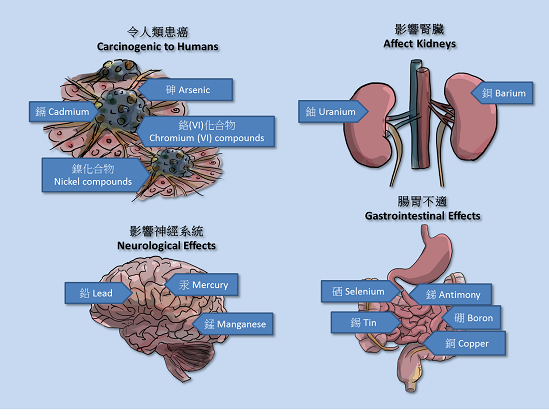
Food Safety Focus (131st Issue, June 2017 ) – Food Safety Platform
Metallic Contaminants: An Overview
Reported by Ms. Janny MA, Scientific Officer,
Risk Assessment Section,
Centre for Food Safety
Metals are natural components of the earth’s crust and ubiquitous in the environment. For some metals such as copper, chromium, manganese and selenium, we need them in trace amount for normal body function but they may cause adverse effects upon excessive exposure. However, some other metals such as arsenic, cadmium and lead serve no functional purpose but can lead to deleterious effects in our body. As metals can enter our food as a result of environmental contamination or during food production process, let’s take a closer look on the metallic contaminants which may be present in our food in this new series of articles.
Adverse Health Effects

Examples of some adverse health effects (may not be the toxicological end-point of concern and not limited to any specific route or duration of exposure) which may be caused by different metallic contaminants in humans and/or laboratory animals.
[Note: Above graphic is for illustration purposes only and the adverse health effects mentioned for each metallic contaminant are neither comprehensive nor exhaustive.]
While it is worth noting that certain chemical forms of the metallic contaminants (e.g. inorganic arsenic and methylmercury) are more toxic than the others (e.g. organic arsenic and inorganic mercury); the risk associated with the consumption of food containing metallic contaminants would also depend on their level present in the food, the amount of contaminated food that is consumed as well as the duration of exposure. Some individual subgroups, e.g. infants and young children, are particularly vulnerable to the adverse effects of certain metals, e.g. lead and mercury.
Previous studies conducted by the Centre for Food Safety showed that there is public health concern for dietary exposure of methylmercury for women of child-bearing age in Hong Kong.
Prevention and Control
In this modern industrial world, the presence of metallic contaminants in our food is in most cases unavoidable. To protect public health, levels of metallic contaminants in food should be as low as reasonably achievable (ALARA) through best practice such as Good Agricultural Practice (GAP) and Good Manufacturing Practice (GMP).
In general, from the consumers’ perspective, what we can do is to maintain a balanced diet so as to avoid excessive exposure to metallic contaminants from a small range of food items.
To Be Continued…
In next article, we will focus on some metals that are identified as of major public health concern, including details of their adverse health effects and ways to reduce their exposure in our diet.


